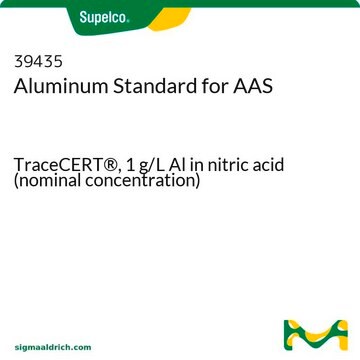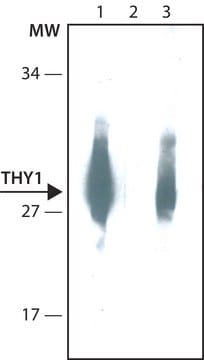MABT117
Anti-Endoglin (CD105) Antibody, clone 44G4
clone 44G4, from mouse
Sinónimos:
Endoglin, CD104
About This Item
Productos recomendados
biological source
mouse
Quality Level
antibody form
purified immunoglobulin
antibody product type
primary antibodies
clone
44G4, monoclonal
species reactivity
human
technique(s)
flow cytometry: suitable
immunohistochemistry: suitable
immunoprecipitation (IP): suitable
isotype
IgG1κ
NCBI accession no.
UniProt accession no.
shipped in
wet ice
target post-translational modification
unmodified
Gene Information
human ... ENG(2022)
General description
Immunogen
Application
Immunoprecipitation Analysis: A representative lot was used by an independent laboratory to IP Endoglin from HOON, NALM-6, 3104, 3161, HL-60, U-937, EM-3 and KG-1a cells (Gougos, A., and Letarte, M. (1988). J Immunol. 141(6):1925-1933).
Cell Structure
Adhesion (CAMs)
Quality
Flow Cytometry Analysis: A 1:200 dilution of this antibody detected Endoglin in HUVEC cells.
Target description
Physical form
Storage and Stability
Analysis Note
HUVEC cells
Disclaimer
Not finding the right product?
Try our Herramienta de selección de productos.
Storage Class
12 - Non Combustible Liquids
wgk_germany
WGK 1
flash_point_f
Not applicable
flash_point_c
Not applicable
Certificados de análisis (COA)
Busque Certificados de análisis (COA) introduciendo el número de lote del producto. Los números de lote se encuentran en la etiqueta del producto después de las palabras «Lot» o «Batch»
¿Ya tiene este producto?
Encuentre la documentación para los productos que ha comprado recientemente en la Biblioteca de documentos.
Artículos
PLTMax® Human Platelet Lysate (hPL) is a superior serum-free and xeno-free media supplement alternative to fetal bovine serum (FBS) for human mesenchymal stem cell (MSC) cultures.
Nuestro equipo de científicos tiene experiencia en todas las áreas de investigación: Ciencias de la vida, Ciencia de los materiales, Síntesis química, Cromatografía, Analítica y muchas otras.
Póngase en contacto con el Servicio técnico





